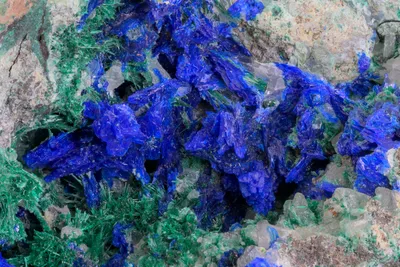Mineral Species
Langite
Type Locality
No
Composition
Cu4(SO4)(OH)6·.2H2O
Crystal System
Monoclinic
Status at Tsumeb
Confirmed
Abundance
Very rare
Distribution
First and second oxidation zones
Paragenesis
Supergene
Entry Number
Species; TSNB201
General Notes
Langite occurs as blue, pale blue or blue-green crystalline crusts and rather more rarely as distinct blue or blue-green crystals (to < 1 mm). It is readily mis-identified, easily confused with posnjakite and analysis is ideally required for verification.
Paar (1973) provided the first formal record of langite at Tsumeb. He described sky-blue crystals of langite (<1 mm) forming aggregates in cracks and depressions on the surface of enargite "drillings" (twins) recovered during an investigation of minerals from levels 34 and 35 (i.e., towards the bottom of the second oxidation zone). He noted devilline, brochantite and an unidentified bluish-white mineral in association with the langite.
Bartelke (1976) reiterated Paar’s (1973) description but added that the reported secondary minerals were found on pseudomorphs of tennantite after enargite. However, Bartelke was unable to identify langite on the pseudomorphs that he examined personally suggesting, perhaps, that it is a less common component of this paragenesis.
Pinch and Wilson (1977) reported an association of bright blue bladed langite crystals with brochantite and devilline but without further elaboration.
Keller (1977a) proposed a paragenetic sequence of (mainly) sulphate minerals which he believed formed under acidic conditions. His sequence "II/3" is as follows:
II/3: primary sulphides >> brochantite + posnjakite + malachite >> linarite >> serpierite
While this sequence does not include langite, Keller (1984) later indicated that langite is an occasional member of this paragenesis which is typically encountered on the surface of tennantite pseudomorphs after enargite. He also noted that it is sometimes associated with smithsonite and cerussite.
Gebhard (1999) described langite as blue crystals (to 1 mm), associated with posnjakite, on corroded pseudomorphs of tennantite after enargite; the langite and posnjakite are hard to distinguish.
A specimen in the MGMH Collection at Harvard University (MGMH 96923) comprises individual striated crystals of blue-green langite (to 0.5 mm), superficially resembling dioptase, on the surface of arsentsumebite pseudomorphs after mimetite. This specimen is from the collection purchased in Tsumeb by Charles Palache in 1922 and is therefore unequivocally from the first oxidation zone.
Associated Minerals
arsentsumebite; brochantite; cerussite; chalcocite; connellite; devilline; enargite; linarite; mimetite; olivenite; posnjakite; serpierite; tennantite-(Zn)






